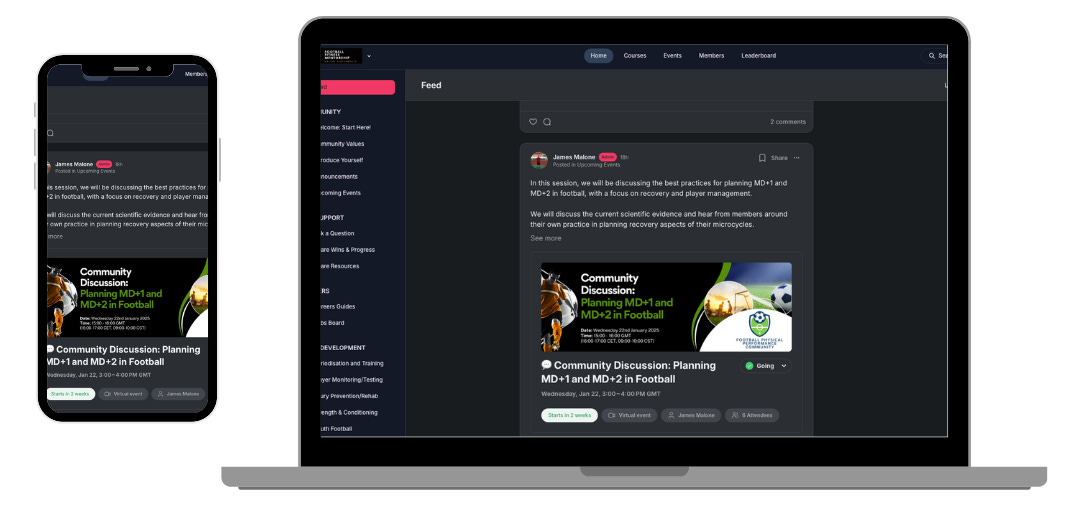The concept of blood biomarker monitoring in football is one that can divide opinion.
In endurance sports, routine blood monitoring both during sessions (e.g. lactate) and between sessions is commonplace to establish the response to training in athletes.
However in football, the culture of the sport is generally against the use of blood biomarker monitoring unless for medical reasons (e.g. venous blood collection for health status assessment).
When you look at the research literature around muscle damage in sport, one of the key blood makers measured is creatine kinase (CK).
CK is an enzyme that is found in your skeletal muscle, heart muscle and brain. When any of these tissues are damaged, they leak CK into your bloodstream.
In theory, if you have an elevated CK value above normal, this can indicate significant muscle damage and can better inform the recovery and match selection process.
Typically in football, CK is collected as part of post-match readiness assessment leading into the next microcycle or match.
For example, in a normal training cycle with one match per week, CK would be measured typically on a MD+1 and/or on MD+2 to inform the training practices for the MD-4(+3) session.
In can also be used during congested fixture periods to potentially better inform player rotation practices for coaches.
Previous research has found a significant correlation between match physical outputs (e.g. accels/decels) and CK levels in the 48 hour post-match window.
There appears to be a stronger association between physical outputs and CK levels in the 24 hours post-match period compared to at 48 hours.
In a study we did back in 2015 on Premier League players, we actually found no relationship between match physical output and CK values at 48 hours post-match.
The first thing to note when using CK in practice is that it is highly variable across players and matches.
Therefore, its difficult to have a hard cut off value for all players due to this variability. Some players have reported CK values as high as 1600 U/L or above previously.
This study published in 2015 reported match-to-match variability of CK being around 35%.
The second thing to note is that its important to have a clear idea about what a players ‘baseline’ value should be.
This can be done following the off-season when in theory players should be fairly rested prior to the commencement of pre-season and subsequently the in-season phase.
Previous studies have reported baseline CK values in players of between 175-500 U/L.
Another way to analyse the data is to establish what a ‘typical’ post-match response from each player looks like.
After collecting several data points (suggest minimum of 5 matches playing full games), you can determine the coefficient of variation (CV%) to better understand the individual variability.
Below is an example of how this would look:
Baseline post-match CK = 700 U/L
Individual post-match CV% = 25%
Post-match CK range = 525 - 875 U/L
Therefore, if a player then had a CK value of say 1000 U/L, this would be red flagged due to it falling outside the expected range of the players post-match data.
From this, the decision might be to rotate the player (if in a congested fixture period) or manipulate their training load for the subsequent week if in a one game/week cycle.
Advanced statistical methods, such as machine learning and Bayesian inferences, have also been applied to blood biomarker data to better understand when a ‘true’ change has occurred.
This great article by Charles Pedlar and colleagues suggests the use of a ‘critical difference threshold (CDT)’ based on biological variation and measurement error of each individual.
The example below from the article is based on a different biomarker but similar principles could be applied to CK.
*blue bars represent weekly training load, squared points represent biomarker collection
Despite its potential usefulness in football, there are some drawbacks when using CK to monitor your players.
Firstly, it can be expensive to conduct the analysis regularly. It requires purchase and maintenance of CK collection equipment (such as Reflotron and CK strips), which will put it out of budget range for most clubs.
Secondly, the CK data can be influenced by physical contacts. For example, a player might receive a hard physical knock in the match but generally feels fine in terms of the running they did. This can result in a false positive outcome based on post-match CK data.
Lastly, CK values collected via capillary sampling (e.g. fingertip) are generally higher than that collected via the gold standard approach of venous sampling (e.g. vein).
With many footballers unwilling to undertake regular venous sampling, capillary blood collection is the only practically feasible way to collect longitudinal biomarker data in football.
Bottom Line - CK can be a useful post-match marker of muscle damage once you evaluate over a longitudinal period accounting for individual variability. Caution must be observed when looking at raw data values without context from other sources (e.g. subjective data, recent training load, etc).
Join The Football Physical Performance Community
Don’t miss your chance to join a global network of practitioners to gain access to 1:1 mentorship, live events with industry leading speakers and enhance your skills through educational content.
Take charge of your career and achieve your goals with expert guidance and resources.
Join 50+ physical performance practitioners as part of a supportive community.
See you next week!
James






Another important consideration is the hourly interval between measurements after the game. The peak is expected approximately 12–18 hours after the game. Earlier or later measurements must be taken into account when interpreting the results. In addition to the maximum peak, the rate of degradation is also an individual factor. 24 hours after the peak, CK drops by approximately 20% to 60%. High endurance players with high ST muscle fibers, on average, achieve a lower peak and recover faster.